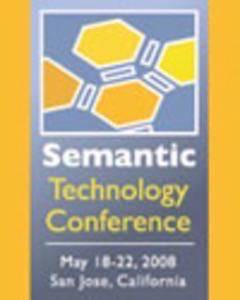What sort of funding opportunities exist in the budding Semantic Web space? What are VCs looking for and how much are they will to invest? That was the topic of a panel at the SemTech 2008 Conference that just concluded in San Jose.
The panel featured Stephen Hall from Vulcan Capital, Eghosa Omoigui from
Intel Capital and Amanda Reed from Palomar Ventures. This post is based on notes from that panel.

The responses presented here are paraphrased. These are not exact quotes.
Question: Talk about your investments in the space? Who did you fund and how much did you put in?
Amanda Reed (Palomar): In 2003 Palomar Ventures funded Attensity,
a text analytics startup that provides insights based on unstructured feedback from customers.
The platform is able to leverage emails, web pages, documents of different types, etc. and then
automatically infers connections between people, places, companies, events, and more to deliver business
insights that otherwise would be buried in unmanageable amounts of text.
The second investment we made was in Silver Creek Systems, which offers information transformation, data extraction and cleansing services. The platform is able to consume and normalize
large volumes of unstructured enterprise data and is currently used in eTailing and financial services markets.
Both companies received funding in $4-7M range from Palomar and $10-15M range overall.
Eghosa Omoigui (Intel): Intel Capital is the investment arm of the Intel Corporation,
and it has $3 billion under management. 93 invest professionals are working with 422 companies on deals ranging
in size from seed stage investments to hundreds of millions of dollars. The most recent investment was in Endeca, which specializes in content aggregation and management for enterprises. We have a lot of interest in the
semantic space and have been following it for over five years. There are several deals that are currently pending
that I can’t name. One is doing dynamic, large-scale ontologies – taking content and overlaying dynamic
ontologies. The company is based out of Asia and will be announced soon.
Stephen Hall (Vulcan): Vulcan Capital started looking into this space in 2004-05.
In addition to several investments in the space, the firm has internal R&D efforts.
We’re excited about the sector and look at it quite broadly. In 2005 Vulcan invested in
ZoomInfo – a company that focuses on extracting information
about people and companies from unstructured text. ZoomInfo offers an application which is both
in vertical search and recruiting/sales intelligence.
Another big investment by Vulcan was a seed round in Radar Networks which recently unveiled its first product, a collaborative semantic
knowledge sharing space called Twine. [ReadWriteWeb’s review — Ed.] I’m excited about Twine,
and believe that the company is paving the way toward a new type of data organization – one that is social. We also invest in a stealth startup called Evri, which is going to launch next week
at the Wall Street Journal conference.
Evri will automatically index the web,
connect people, places and other entities and offer a way to shortcut search. The bigger promise
of semantics is not to improve search, but to avoid it all together, because once context is known, relevant
information can be inferred. We believe that Evri will deliver a new and disruptive way of bringing us information.
Lastly, Vulcan funded a company in the email space, which is still in stealth mode. It aims to apply semantic technologies to mining information buried in emails.
Question: During this conference an executive from Oracle claimed that semantic technologies
are not going to reach the mainstream on their own. Instead they will be absorbed by large enterprise products, such as Oracle’s. Can you comment on that?
Stephen Hall (Vulcan): That’s not so. There are tremendous opportunities in the space.
If we did not believe that, we would not have made all the investments that we have. The
the amount of unstructured information out there is huge and rapidly growing, creating
more and more need for automatic/semantic technologies to cope with the information explosion. This
need is what drives the opportunities both in the consumer and enterprise space.
Question:
Nova Spivack said that most VCs are looking for only 1 play in the Semantic Web space, is that true?
Also, someone else commented that VCs would rather invest in applications instead of platforms. Is that so?
Amanda Reed (Palomar): VCs do not think about this as a single market.
Those venture capitalists who really understand the power of semantic technologies do not fund companies because
they use the technologies, they fund companies for which there is market need and opportunity.
VCs want to put money into companies that are solving real problems and have clear user benefits.
Having semantic technologies as infrastructure is certainly interesting and impressive, but
by no means is it a deciding factor.
It is true that VCs like apps over platforms. Platforms have traditionally had a challenge with pricing.
In all of the investments that Palomar has made in this space, a big focus has been on pushing companies to build applications
on top of platforms. Another important observation to make is that once a platform is turned into an application
and it reaches customers, the word semantic disappears from the marketing. Enterprise customers,
like consumers, simply do not need to know what is inside as long as it works and solves the problem.
Eghosa Omoigui (Intel): One of the strategies that is interesting in the semantic
space is the stack of solutions based on a theme. There is a great diversity in semantic web technologies
and problems, so by adopting this as a theme, VCs can build a portfolio of companies that collectively
offer solutions along the entire stack. One needs to look for the best company in each
niche, with a clear proposition and superior technology. And so with that, if someone says we only
invest in 1 company in the space, run, because that means they don’t get the space.
Question: Give us examples of particular market areas where you see opportunities now.
Amanda Reed (Palomar): Enterprise infrastructure investments. Product transformation, data quality,
cleaning data. There is big pressure to reuse data in different applications and services. People tend to shy away
from the enterprise because of the lengthy sales cycles and costs to scale the sales, but there is a lot of money
to be made.
Stephen Hall (Vulcan): There are a lot of light-weight services
that are beginning to tap and re-wire the existing web. As an early example, SmartLinks from AdaptiveBlue
leverages existing URLs as semantic markers. These type of top-down contextual / semantic technologies that are leveraging existing bits of the web are just in their infancy and we will see much more in the space. Another variety of consumer technologies that have a lot of promise are things like Trippit.
Taking unstructured information from email, recognizing it, cleaning it, and inserting it automatically into iCalendar is an example
of applying semantic technologies to consumer task automation. There are lots of opportunities like this in the consumer space.
Amanda Reed (Palomar): Speaking of Trippit, the space is not semantics, the space
is really travel. Semantics is really the means to an end, but not the main point. We are excited about the
companies that put semantic technologies to good use in verticals and solve real, specific problems.
Question: How do you expect to make money on the Semantic Web? What are the monetization strategies that you are seeing?
Stephen Hall (Vulcan): It really depends on the company and the business model. Twine will be partially
monetized via advertising, but there will be other components. In general, Vulcan quite likes the advertising space, which will be doubling to
$40B with room still for growth. Semantic technologies that are impacting ad quality is another interesting area.
There are companies in that space, for example Dapper, that are leveraging semantics to deliver
more targeted, more contextual advertising.
Amanda Reed (Palomar): There are several business models that we are seeing out there.
Most often, it is a web service or service offering. There are licenses in the enterprises as well, of course.
In addition, we are seeing new models where services are packaged into boxes and bundled with software. This is
a hybrid model that seems to be interesting to many enterprises because of the finer control. It is important for startups to figure out how to match the value proposition to the business model.
Question: How are today’s funding models different from, say, 5 years ago? How much capital do startups need
these days typically in series A, series B?
Amanda Reed (Palomar): Cloud computing has changed the startup game in a very significant way.
The cost to get to market is substantially lower as more startups are now able to buy critical infrastructure from companies like Amazon.
Stephen Hall (Vulcan): There is really no formula for how to fund a company.
Deciding on a capital needs depends on many factors. Some companies need $10M, some need $50M and
there is a comparable upside. Some of the opportunities today simply could not have existed yesterday because
we did not have the scalable and readily available grid infrastructure.
Eghosa Omoigui (Intel): Intel has launched amazing products
for deploying cutting edge tech. This drives the value for every dollar. Another
big difference is outsourcing, which has had a dramatic impact. These days you can hire a stellar
development team in Eastern Europe at a fraction of the cost of one in the US or even Asia.
In general, there is a big difference between launching a software and a hardware business.
Chip businesses can require hundreds of millions of dollars to get going, but software is on the order of magnitude
cheaper to build. Everything is dependent on the target market.
Amanda Reed (Palomar): Another important thing to keep in mind is that VCs are looking
for entrepreneurs who know how VC firms work. For example, the size of the investment is driven by the size
of the fund. A billion dollar fund does not have capacity to put $1M into the company. A partner can only focus
on 5-7 companies and to make it worthwhile for the fund, each investment needs to be much more substantial.
A lot of entrepreneurs do not understand that and apply to funds that are unable to fund them.
Question: What are the proof points that you look for for series A and B funding?
Stephen Hall (Vulcan): Series A, pre-product pre-revenue, you need to
have comfort that the team understands technologies and can manage issues around scale.
Particularly in the web space, scale is critical. Also, looking for passionate people with past success. The biggest thing, which is often missing, is a go-to-market strategy. VCs will help refine the path,
but you need to have clarity to have success.
Eghosa Omoigui (Intel): Too many use cases is always something that plagues this industry.
When there are many use cases, there is a lack of focus. Go and figure out where the need is. It is most important not to get it right, but to articulate the problem and to know what you are after.
Question: How early are you getting into companies and what is the mininimum you are putting in?
Eghosa Omoigui (Intel): Depends on the opportunity. We do everything from $300K seed funding to $300M rounds.
Amanda Reed (Palomar): We like early stage. We will do a $250K seed deal if we know that series A is coming. We tend to top out in high $20M pre-money valuations.
Stephen Hall (Vulcan): Depends on the deal but we prefer early, series A.
Can do less than $1M and seek to put in $10M over the lifetime of the company.
Disclosure: Alex Iskold is Founder/CEO of AdaptiveBlue.

















